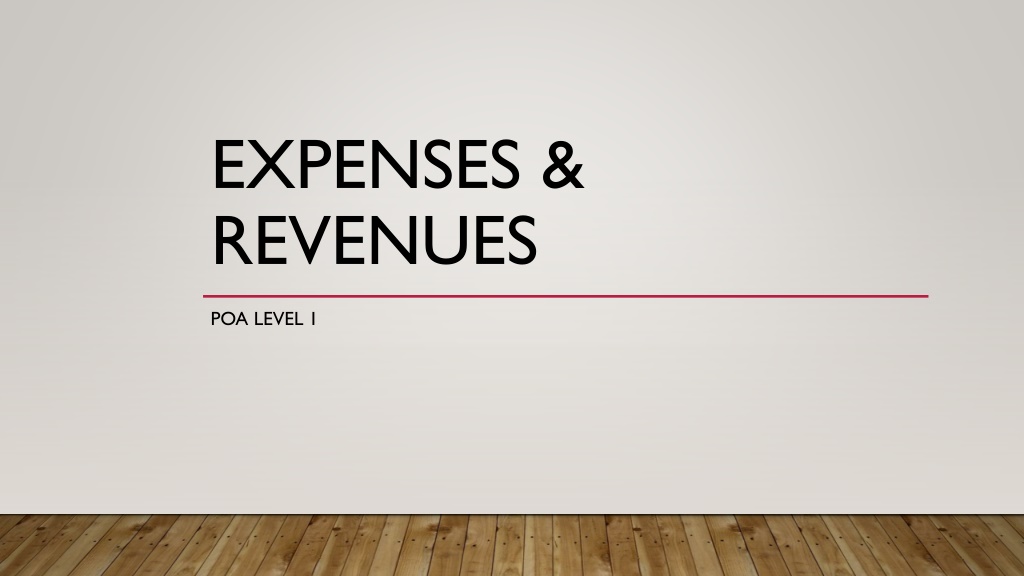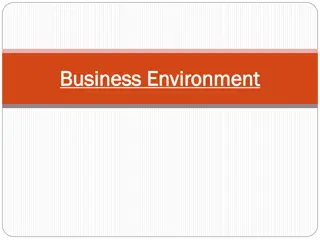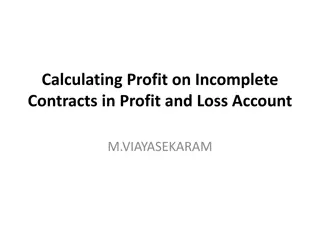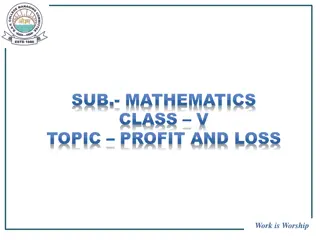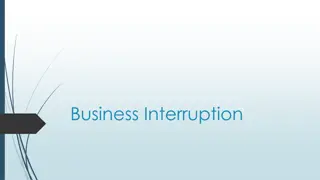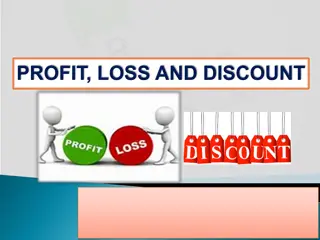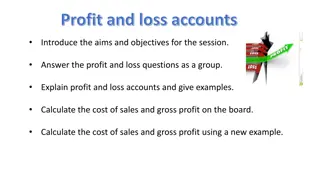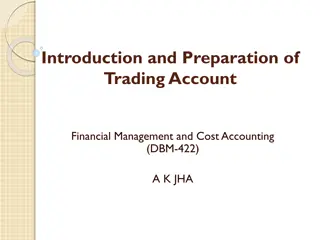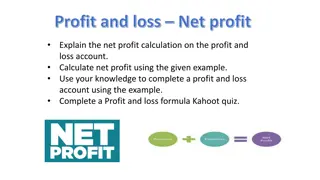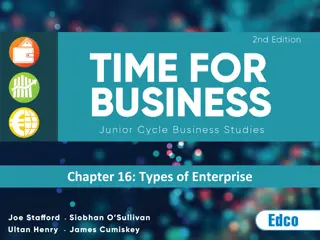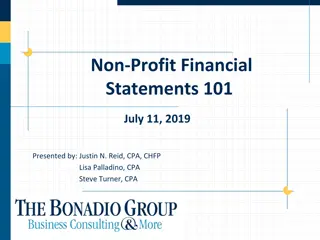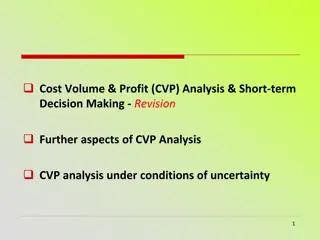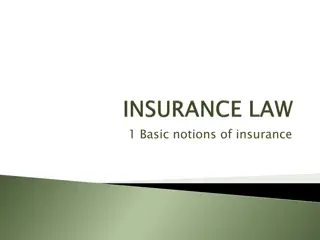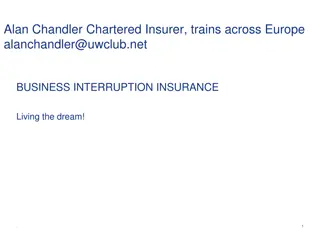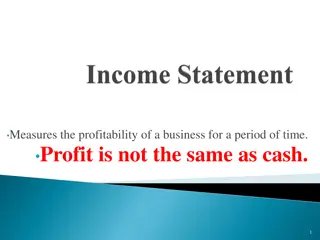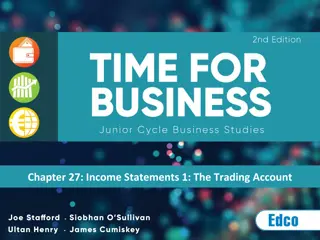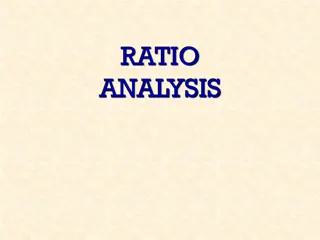Understanding Business Profit and Loss – Key Concepts and Procedures
This educational content delves into the fundamental concepts of business profit and loss, explaining how they impact capital or owner’s equity. It covers topics such as different types of expenses and revenues, double-entry procedures for recording transactions, and the effects of profits and losses on a business's financial position. By the end of the lesson, learners should grasp how business operations impact financial outcomes and equity.
Download Presentation

Please find below an Image/Link to download the presentation.
The content on the website is provided AS IS for your information and personal use only. It may not be sold, licensed, or shared on other websites without obtaining consent from the author. Download presentation by click this link. If you encounter any issues during the download, it is possible that the publisher has removed the file from their server.
E N D
Presentation Transcript
EXPENSES & REVENUES POA LEVEL 1
BY THE END OF THIS LESSON, YOU SHOULD BE ABLE TO ANSWER THE FOLLOWING QUESTIONS: How does a business make a profit or a loss? How does profit affect capital or owner s equity? How does a loss affect capital or owner s equity? Why is there a need to separate different expense and revenue accounts? What is the double entry procedure for recording expenses? What is the double entry procedure for recording revenues? Who, what or when is drawings?
PROFITS VERSUS LOSSES PROFIT means the amount by which revenues are greater than expenses for a set of transactions. LOSS occurs when the amount of expenses exceed the amount of revenues for a set of transactions.
PROFIT VERSUS LOSS If a business makes a profit, that profit belongs to the owner/owners of the business and consequently their capital is increased by that amount. If a business makes a loss, that loss is against the capital the owner/owners of the business invested and consequently their capital is reduced by that amount. Loss reduces capital Profit therefore increases capital Drawings will also reduce capital Old Capital + Profits = New Capital Old Capital Loss = New Capital
Types of Expenses include: Salaries and Wages, Travel expenses, Electricity, Water, Internet, Telephone, Computer Repairs, Rent Payable, Commissions Payable, Discounts Allowed TYPES OF EXPENSES AND REVENUES Examples Types of Revenues include: Sales Revenue, Tuition, Rent Receivable, Commission Receivable, Discounts Received
RECORDING REVENUES & EXPENSES Different types of revenues should be recorded in separate accounts to provide information of the income received. Likewise, different types of expenses should be recorded in separate accounts to enable the business to identify various areas of expenditure such as motor expenses, stationery, etc. Expenses owing are examples of liabilities. Therefore, when expenses are paid, these transactions reflect liabilities DECREASING. According to our double entry rules, when a transaction causes a liability to decrease, that account should be DEBITED. Expense accounts are therefore debited when paid. What do you think should be the double entry for Revenues? Revenue accounts are CREDITED as revenues or increase in income represent transactions which increase Capital or Owner s Equity. When Capital increases we credit.
Drawings are the resources (cash or kind) withdrawn from the business by the owner/owners for personal use. Drawings are recorded in a separate account and then deducted from the owner s capital account. Though an expense, drawings is not recorded in the expenses of the business but instead, against the owner/owners capital account. THE SPECIAL NATURE AND TREATMENT OF Drawings is therefore NEVER included in the Income Statement/Profit & Loss A/c of the business. DRAWINGS Drawings however is featured in the Balance Sheet/Statement of Financial Position under the Financed By/Owner s Equity section.
LETS GET TO PRACTICING NOW!!! EXERCISE 8.2 Transaction Paid rent by cash Paid for goods by cash Received by cheque a refund for rates already paid Paid general expenses by cheque Received commissions in cash Goods returned by us to T. Jones Goods sold for cash Bought office fixtures by cheque Paid staff in cash Took cash out of business for private use Account to be Debited Rent Purchases Bank Account to be Credited Cash Cash Rates A B C D E F G H I j General Expenses Cash T. Jones Cash Office Fixtures Wages Drawings Bank Commissions Receivable Purchase Returns Sales Bank Cash Cash
LETS GET TO PRACTICING NOW!!! EXERCISE 8.3X Transaction Paid insurance in cheque Paid motor expenses by cash Rent received in cash Paid rates by cheque Received refund of rates by cheque Paid for stationery expenses by cash Paid staff by cash Sold surplus stationery receiving proceeds by cheque Received sales commission by cheque Bought motor van by cheque Account to be Debited Insurance Motor Expenses Cash Rate Bank Stationery Expenses Wages Bank Account to be Credited Bank Cash Rent Receivable Bank Rates Cash Cash Stationery A B C D E F G H I j Bank Sales Commission Bank Motor Van
HOMEWORK USING THE T-ACCOUNTS EXERCISE 8.5 Date 2017 Jan 1 Jan 2 Jan 3 Jan 5 Jan 6 Jan 7 Jan 8 Jan 10 Jan 12 Jan 25 Jan 31 Transaction Started business with $20,000 in the bank U. Surer lent us $10,000, giving us the money by cheque Bought goods on credit, $2,960 from T. Parkin Bought motor van by cheque $7,500 Cash sales $1,050 Paid motor expenses in cash $150 Paid wages in cash $780 Bought goods on credit from C. Moore $850 Paid insurance by cheque $220 Received commission in cash $1,500 Paid electricity bill by cheque $370
HOMEWORK USING THE T-ACCOUNTS EXERCISE 8.8X Transaction Date 2017 July 1 Started business with $8,000 in the bank July 2 Bought stationery by cheque $30 July 3 Bought goods on credit from I. Walsh $900 July 4 Sold goods for cash $180 July 5 Paid insurance by cheque $40 July 7 Bought machinery on credit from H. Morgan $500 July 8 Paid for machinery expenses by cheque $50 July 10 Sold goods on credit to D. Small $320 July 11 Returned goods to I. Walsh $70 July 14 Paid wages in cash $70 July 17 Paid rent by cheque $100 July 20 Received cheque $200 from D. Small July 21 Paid H. Morgan by cheque $500 July 23 Paid stationery on credit from Express Ltd. $80 July 25 Sold goods on credit to N. Thomas $230
